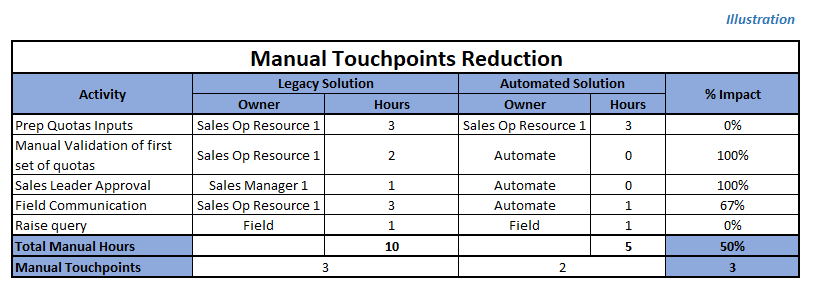A guide to increase ROI of your Incentive Compensation Solution
by Sumeet Shah
- Nov 19, 2020
- 5 min read

Businesses are constantly evolving due to changing market environments and regulations. This has introduced several new sales, support and scientific roles as a part of the broader selling process. Besides, localized variations in regulations and the broader sales ecosystem have added further complexity. Growing organizations using Excel workbooks or home-grown legacy systems for incentive compensation management are spending a significant amount of manual time in managing exceptions. Research has proven that there is an 88% chance of errors using Excel spreadsheets for calculations. This has led businesses to move to evaluate enterprise-grade sales compensation management platforms for their needs. Additionally, our conversations confirm that the Incentive Compensation process is graduating from a support function to an important driver in salesforce engagement.
Over the past few years, we noticed that organizations have a highly myopic view of the Incentive Compensation process. The focus is more on reducing payout errors, and it is not viewed as a strategic driver that can help them improve topline, salesforce engagement and reduce attrition of top performers. However, there are several factors to consider while identifying and implementing an enterprise-grade incentive compensation solution suite. As a part of 2 blog series, this article covers 5 key metrics to focus on while implementing an Incentive Compensation solution followed by next one that covers key metrics to focus on while selecting an IC solution:
1. Turnaround Time Reduction -
This is the total time needed from the start to the closure of a request. Let’s look at the refinement part of the target setting or the goal setting process as an example. It starts with pushing the set quotas to the highest level and allowing sales leadership to adjust quotas for their reporting reps/managers. Finalized quotas are then pushed to the Sales Operations team for final review which are then used in IC calculation. On an average, this process takes anywhere between a week to couple of weeks.
An effective IC solution should automate the end-to-end process and enable sales operations teams and other stakeholders to manage processes with the click of a button. Automation of manual validations, built-in detailed reports and access to timely insights and visualization can reduce the entire process time significantly and release payouts sooner to the field.
2. Manual Efforts Reduction -
These are the total number of manual hours spent by an individual fulfilling a request. If we look at the quota refinement example from above, there are various manual tasks that entail data formatting, exception handling and resulting adjustments, data and dispute follow ups etc. These peripheral tasks increase the overall resource needs as well as the processing time. For a monthly payroll cycle, this is how the math looks like;
A good IC system should help you significantly reduce these manual efforts. Organizations should invest these saved hours in value add activities that otherwise may be pushed out because of lack of bandwidth.
3. Manual Touchpoints Reduction -
Ideally, each step involved in the process should require a lesser number of resources. As multiple individuals touch specific steps/processes manually, the chances of errors go up significantly, translating to a dollar amount loss. An out-of-the-box IC solution that enables end-to-end automation and comes with built-in workflows eliminates redundant touchpoints.
4. Payout Error Reduction -
Research has proven that legacy solutions and Excel workbooks lead to overpayments of around 3% to 8%; typically attributed to formulae errors and manual interventions. As an example, for a salesforce of 100 reps who are eligible for sales incentives of $36K per year, your organization is at risk of overpaying and causing indirect losses of anywhere between 100K to 300K per year
5. Total Cost of Ownership Reduction -
The COVID pandemic has taught there is going to be an ongoing need to tweak plans, plan parameters, quota refinement, and simulation of varying scenarios outside regular annual plan changes. As per research, an organization spends $1500 per participant to administer these plans and associated changes. For a salesforce of 100 reps, this translates to 150K which at times exceeds the actual cost of the solution.
Organizations need to look at a holistic set of metrics like the ones above while implementing IC solutions. It is essential to keep a close eye on implementation and licensing costs while evaluating a new incentive compensation solution. In addition, it is equally important to understand the costs that are going to be incurred for ongoing operations and change management. The fact is that the cost incurred managing the solution hurts the most not only because of cash outflow but also because of valuable analyst time that goes into managing day-to-day operations instead of understanding trends, and patterns, and turning ideas into innovation.
Feel free to reach out to us at sumeet.shah@aurochssoftware.com in case you have any questions or to talk about your current challenges and bounce off any ideas with no strings attached.



- Sep 11, 2020
- 4 min read
by Amit Jain

- Sep 09, 2020
- 4 min read
by Sujeet Pillai

- Nov 07, 2022
- 4 min read
by Sujeet Pillai
What our Clients are saying






